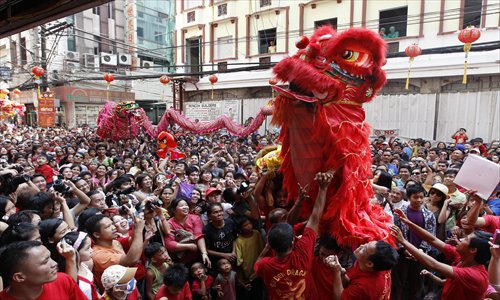HOME >> WORLD
Feeling the squeeze
By Zhu Ning in Manila and Wang Zhaokun in Beijing Source:Global Times Published: 2013-9-9 23:43:02

Filipinos perform a dragon dance outside a grocery store as they mark Chinese New Year in the Chinatown district of Manila in January. Photo: CFP
Manila Chinatown, which has become one of the most prosperous areas in the city, is now plagued by problems such as soaring housing prices, traffic congestion and crime.
Ann Perez, a mother of three who lives in Manila, always goes shopping for her family on weekends. She told the Global Times one of her favorite shopping hubs is Manila Chinatown.
"The products in the shopping malls at Manila Chinatown are cheap and complete. You can find almost any daily necessities here. My friends and I come here for shopping regularly, especially on holidays," Perez said.
But Perez complained that the traffic conditions in Manila always force her have to leave home very early and return late.
"Traffic congestion is commonly seen in the whole of Manila, but in the Chinatown area, this is getting more obvious and acute," she noted. "The public security situation in the area is also a problem."
Perez's words are a clear illustration of the current situation in Manila Chinatown.
Continued prosperity
As early as the Ming dynasty (1368-1644), many Chinese peddlers and craftsmen from China's southeast coastal areas came to Manila and settled down in an area in the north of the city. Due to their hard work and persistence, the Chinese communities not only survived, but flourished.
But the real history of Manila Chinatown could be dated back to the 1890's, when a major street in Manila was named after Don Roman Ongpin, a famous businessman whose father was an immigrant from China's Fujian Province.
Ongpin risked much of his business and fortune to support the Philippine revolution of 1896 against the Spanish colonists.
Manila Chinatown is located just across the Pasig River opposite the former Intramuros or Walled City, the fortified center area in Manila established during the Spanish occupation of the Philippines that was home to the Spanish colonists and their families.
The location of Manila Chinatown demonstrates the importance and prosperity it enjoyed at the time. This status has basically been maintained until today.
Manila Chinatown is a must-see for many tourists coming to the city, as the place is home to many special Chinese products.
"Manila Chinatown is a trading hub for products made in China such as clothes and accessories, and there are also many special Chinese restaurants. So for many people in the Philippines, especially Chinese, the area is really an integral part of their lives," a Chinese-Filipino named Lin who teaches at a local school told the Global Times.
In fact, you could find almost any product popular in China here in Chinatown, ranging from traditional chili sauce to electrical equipment.
Among the most famous shopping malls in Chinatown is "168," where many Filipinos also frequently go to "sweep goods," Lin said.
The success of earlier Chinese immigrants and the number of business opportunities in Manila is prompting an increasing number of Chinese to come to the city and settle down in Chinatown, legally or otherwise.
"The economic status of Chinese-Filipinos is relatively high in the Philippines as Chinese immigrants in the Philippines mainly specialize in business and trade activities. This stands in sharp contrast to the scenario in some other countries, where many Chinese immigrants would first go as laborers," Zhuang Guotu, dean of the Research School of Southeast Asian Studies at Xiamen University, told the Global Times.
"This is a result of tradition, because when the Chinese first came to the Philippines hundreds of years ago, they started doing trade business and such a tradition was able to be sustained till now," he said.
Practical problems
While the inflow of immigrants in the area injected more energy into Chinatown's development, this has also created some problems and difficult challenges.
Since many new immigrants do not speak the local language, they often choose to live in Manila Chinatown, where they can communicate in Chinese. But even for those who settled down here a long time ago, it is hard for them to buy an apartment in the area.
"The increasing population density has made land here scarce and expensive, and to make things worse, the majority of the houses in the Chinatown were built many years ago and were old two-story buildings," said Chu Mao, a Chinese-Filipino furniture businessman in Chinatown. "The area utilization efficiency of such buildings is relatively low."
The security situation in Manila Chinatown has also deteriorated in recent years with the area getting increasingly complex in terms of population composition and criminals targeting rich businessmen.
In November, three Chinese-Filipino businessmen were killed in three days in two robbery cases.
But despite these challenges, Chinese businessmen say they still want to stay in the area, which they rely on for their living and business.
Christopher Chao, 30, runs an electrical appliance shop in Chinatown. He told the Global Times that he had once wanted to move to city of Makati, where business and security conditions are better. "But many of my old clients live here. They are unable to move with us. And my parents also said they are used to the life here. So we decided to stick to it," he said.
Zhuang said the challenges that Chinatown and Chinese-Filipinos are faced with are closely and practically related to the social and economic realities in the Philippines.
"The wealth gap is a serious issue in the country and there are large numbers of poor people. Chinese are easily targeted in criminal activities such as robberies and kidnapping as they impress locals as being relatively richer people," he noted.
Posted in: Asia-Pacific, Asia in Focus